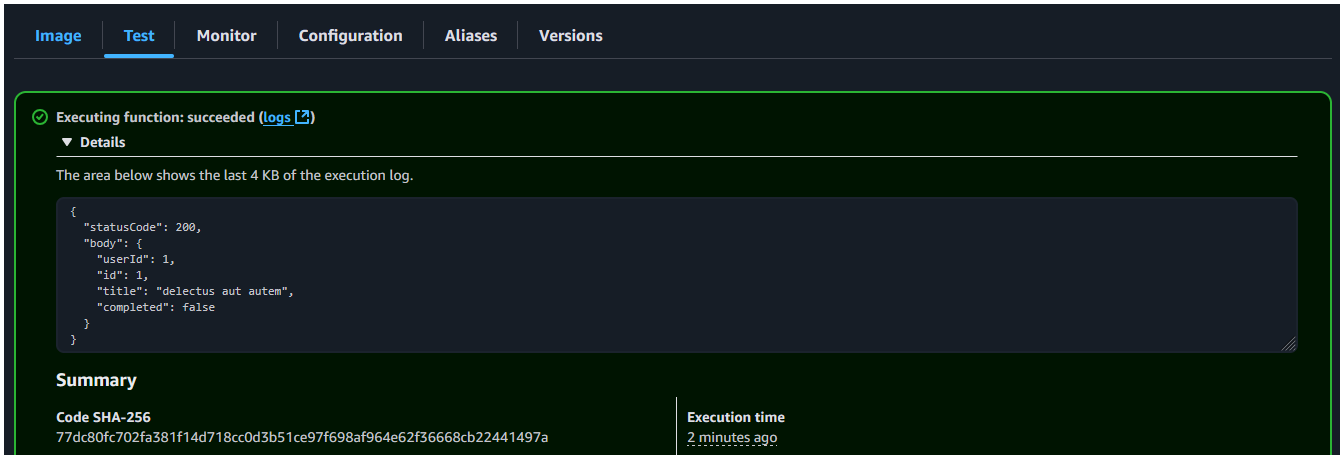How to create a Lambda function in a ECR Docker image using AWS CDK in Python
In previous posts we looked at how to create using AWS CDK:
- Default Lambda function,
- Lambda function with Python dependencies using a Lambda layer
- Lambda function with Python dependencies that uses AWS provided Docker image
But in some cases, you may need to modify the Docker image that AWS Lambda uses. E.g. you may need to install additional dependencies or modify the runtime.
In this post, we'll look at how to create a Lambda function using a AWS provided Docker image.
Prerequisites
- Ensure that you have AWS CDK and SAM CLI installed.
- If needed create a new CDK application.
Create a Lambda function using a ECR Docker image
We will need to do the following:
- Create the
Dockerfile - Create a
requirements.txtfile to specify the Python packages to be installed. - Write the lambda function.
- Create the lambda stack.
1. Create the Dockerfile
Let's create a lambda directory in cdk_app to store the files for this function.
# filename: cdk_app/lambda/Dockerfile
FROM public.ecr.aws/lambda/python:3.12
# Copy requirements.txt
COPY requirements.txt ${LAMBDA_TASK_ROOT}
# Install the specified packages
RUN pip install -r requirements.txt
# Copy function code
COPY index.py ${LAMBDA_TASK_ROOT}
# Set the CMD to your handler
CMD [ "index.handler" ]
Within this image we have:
- Identified the image that we want to use. In this case we are using the AWS provided Python 3.12 image.
- Copied the
requirements.txtfile to the image. - Installed the specified packages.
- Copied the function code to the image.
- Set the command to be executed when the container starts.
2. Create a requirements.txt file
Create a new file called requirements.txt in the cdk_app/lambda directory. Any Python packages that you may need to install can be added to this file.
requests
3. Create the lambda function
Within the lambda directory create a new file called index.py. This is the main Python file that will be executed by the Lambda function.
# filename: cdk_app/lambda/index.py
import requests
def handler(event, context):
response = requests.get("https://jsonplaceholder.typicode.com/todos/1")
return {"statusCode": 200, "body": response.json()}
4. Create a lambda_stack.py file
We modify the lambda_stack.py file to create the CDK stack.
# filename: cdk_app/lambda_stack.py
from aws_cdk import (
Stack,
aws_lambda as _lambda,
)
from constructs import Construct
class LambdaStack(Stack):
def __init__(self, scope: Construct, construct_id: str, **kwargs) -> None:
super().__init__(scope, construct_id, **kwargs)
fn = _lambda.DockerImageFunction(
self,
"LambdaFunction",
code=_lambda.DockerImageCode.from_image_asset("cdk_app/lambda"),
)
In the above code we use the DockerImageFunction construct to create the Lambda function. It takes the following arguments:
self: The construct itself.id: The unique identifier for the function.code: The Docker image code. In this case we are using theDockerImageCode.from_image_assetmethod to specify the path to the Docker image.environment: The environment variables for the function. This is not required but is useful for testing purposes.
Compared to previous examples, we don't need to identify the handler function as this is specified in the Dockerfile.
Now finally, let's initialise the stack by creating the app.py file.
# filename: app.py
import aws_cdk as cdk
from cdk_app.lambda_stack import LambdaStack
app = cdk.App()
lambda_stack = LambdaStack(app, "LambdaStack")
app.synth()
To deploy the stack, run cdk deploy.
When the lambda function is deployed, you can go to the console and test the function. It should show the below output.
